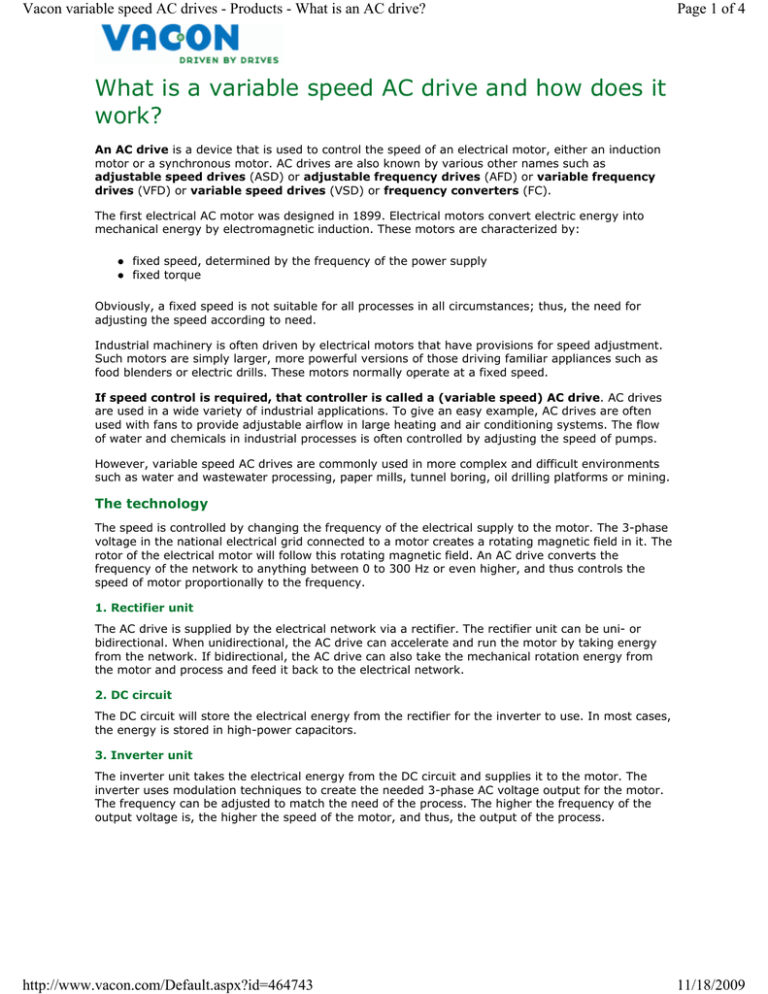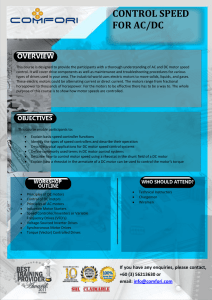
Vacon variable speed AC drives - Products - What is an AC drive?
Page 1 of 4
What is a variable speed AC drive and how does it
work?
An AC drive is a device that is used to control the speed of an electrical motor, either an induction
motor or a synchronous motor. AC drives are also known by various other names such as
adjustable speed drives (ASD) or adjustable frequency drives (AFD) or variable frequency
drives (VFD) or variable speed drives (VSD) or frequency converters (FC).
The first electrical AC motor was designed in 1899. Electrical motors convert electric energy into
mechanical energy by electromagnetic induction. These motors are characterized by:
z
z
fixed speed, determined by the frequency of the power supply
fixed torque
Obviously, a fixed speed is not suitable for all processes in all circumstances; thus, the need for
adjusting the speed according to need.
Industrial machinery is often driven by electrical motors that have provisions for speed adjustment.
Such motors are simply larger, more powerful versions of those driving familiar appliances such as
food blenders or electric drills. These motors normally operate at a fixed speed.
If speed control is required, that controller is called a (variable speed) AC drive. AC drives
are used in a wide variety of industrial applications. To give an easy example, AC drives are often
used with fans to provide adjustable airflow in large heating and air conditioning systems. The flow
of water and chemicals in industrial processes is often controlled by adjusting the speed of pumps.
However, variable speed AC drives are commonly used in more complex and difficult environments
such as water and wastewater processing, paper mills, tunnel boring, oil drilling platforms or mining.
The technology
The speed is controlled by changing the frequency of the electrical supply to the motor. The 3-phase
voltage in the national electrical grid connected to a motor creates a rotating magnetic field in it. The
rotor of the electrical motor will follow this rotating magnetic field. An AC drive converts the
frequency of the network to anything between 0 to 300 Hz or even higher, and thus controls the
speed of motor proportionally to the frequency.
1. Rectifier unit
The AC drive is supplied by the electrical network via a rectifier. The rectifier unit can be uni- or
bidirectional. When unidirectional, the AC drive can accelerate and run the motor by taking energy
from the network. If bidirectional, the AC drive can also take the mechanical rotation energy from
the motor and process and feed it back to the electrical network.
2. DC circuit
The DC circuit will store the electrical energy from the rectifier for the inverter to use. In most cases,
the energy is stored in high-power capacitors.
3. Inverter unit
The inverter unit takes the electrical energy from the DC circuit and supplies it to the motor. The
inverter uses modulation techniques to create the needed 3-phase AC voltage output for the motor.
The frequency can be adjusted to match the need of the process. The higher the frequency of the
output voltage is, the higher the speed of the motor, and thus, the output of the process.
http://www.vacon.com/Default.aspx?id=464743
11/18/2009
Vacon variable speed AC drives - Products - What is an AC drive?
Page 2 of 4
Figure 1: The main components of an AC drive: rectifier, DC circuit and inverter
The benefits
The types of motors that AC drives control are normally operating at constant speed.
Enabling the user to control the speed of motor potentially gives him various benefits in terms of
process control, system stress and energy savings.
Adjusting speed as a means of controlling a process
z
z
z
z
z
z
z
z
Smoother operation
Acceleration control
Different operating speed for each process
Compensate for changing process variables
Allow slow operation for setup purposes
Adjust the rate of production
Allow accurate positioning
Control torque or tension
System stress
z
z
Reducing the start-up current, which allows use of smaller fuses and supply connections and
reduces peak loads on the electrical network
Reducing the mechanical shock in start and stop situations
Saving energy by using AC drives
An AC drive often uses less energy than an alternative fixed speed mode of operation. Fans
and pumps are the most common energy saving applications. In these applications, energy savings
are typically 20-50%.
When a fan is driven by a fixed speed motor, the airflow may sometimes be higher than it needs to
be. Airflow can be regulated by using a damper to restrict the flow, but it is more efficient to
regulate the airflow by regulating the speed of the motor.
See also: Calculate how much energy Vacon AC drives can save in pump and fan applications
Case study: AC drives in HVAC applications
40% of all energy in Europe and North America is consumed in buildings. The biggest share
of this energy is consumed in heating, ventilation and air conditioning (HVAC) applications.
With the rising energy cost and concerns about the CO2 levels and global warming, it is crucial to
use all means available to reduce the energy consumption in HVAC applications. The savings
potential is big.
The key thing is to start looking more at lifetime costs of HVAC system, where energy cost plays a
big role, rather than the initial investment in HVAC system. To give an example, 90% of the
lifetime costs of the pump or fan is energy.
The majority of HVAC applications where AC drives are used are
z
fans
http://www.vacon.com/Default.aspx?id=464743
11/18/2009
Vacon variable speed AC drives - Products - What is an AC drive?
z
z
Page 3 of 4
pumps
compressors.
Figure 2: The main components of an HVAC system: air circulation, water cooling circuits and water
heating circuits.
1. Fans and pumps
Using an AC drive to control the fan or pump output rather than using dampers, vanes, valves or
on/off control brings substantial energy savings, if the required output is less than nominal most of
the time.
The AC drive controls the speed of the pump and fan by changing the electrical energy supplied
rather than damping the air- or water flow. It is like reducing the speed of a car by pressing less on
the accelerator instead of using the brake to slow down the speed. The payback time of an AC
drive is typically one year or less.
http://www.vacon.com/Default.aspx?id=464743
11/18/2009
Vacon variable speed AC drives - Products - What is an AC drive?
Page 4 of 4
Graph 1: Electrical power consumed by pump at partial loads is significantly less with an AC drive
than with valve or on/off control.
Other benefits of using AC drive to control the speed of fan or pump are:
z
z
z
Smooth ramp up and ramp down causes less stress to the mechanics of fans and pumps and
to air ducts and water piping
Slowing down the speed rather than damping the output will result in lower noise levels
Tuning the HVAC system during and after the commissioning is easier when the flexibility of
an AC drive is used
2. Compressors
Compressors in HVAC are often used in chillers for cooling water, which again is used for
cooling air. Utilising AC drives in compressor applications will potentially bring energy savings
compared to on/off control.
Energy savings are achieved by optimising the system setup of compressor, chilled water circulation
and condenser water circulation. The optimum set point for chilled water temperature and condenser
water temperature is based on outdoor and indoor temperature and humidity.
The energy savings are most effectively achieved by tuning the system rather than
optimizing individual functions. The AC drive gives the flexibility of tuning the setup of the system to
operate in the most energy efficient operational point.
Other benefits
z
z
z
z
Reduced number of starts and stops reduces the wear of the compressor
The piping and mechanics are stressed less in ramp up or –down situations
Reduced noise level in low load situations
Possibility to use high speed compressors
Copyright © Vacon Plc, a member of Vacon Group. All rights reserved.
http://www.vacon.com/Default.aspx?id=464743
11/18/2009



